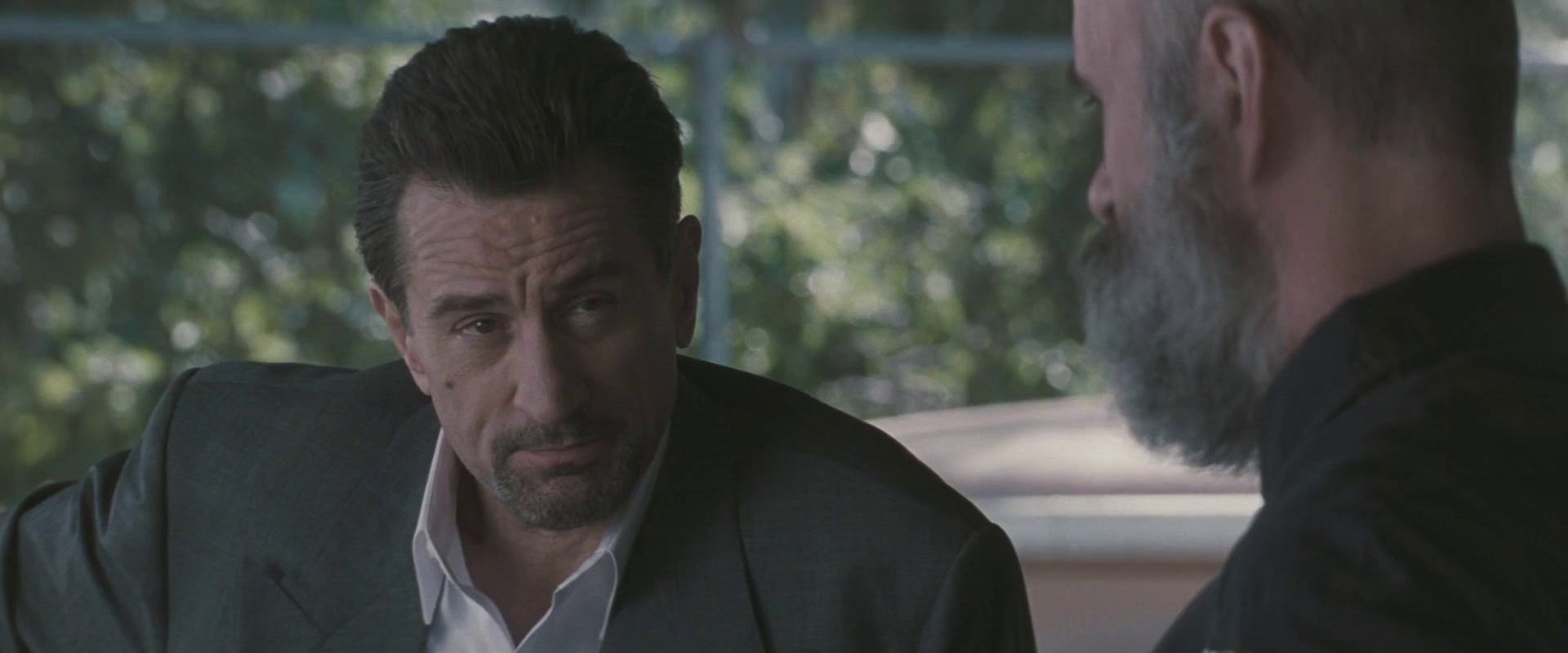Empathy was yesterday
“Empathy was yesterday”
This world within a world idea is further deepened as we see Hanna and Macauley apply their reflecting methodologies: the former following up on leads, and the latter tying up loose ends with Waingrow.
As Macauley arrives, we see him vent his frustrations in full view of the surrounding diners.
We then see an exchange between Cheritto and an onlooker at the next table. While no words are said, the meaning contained within is clear:
The small American flag next to Waingrow subtly reminds us that this is the normal world, but the actions of this crew are not in sync with it. Despite the disturbing nature of the activity before them, the diners turn a blind eye to it. While this is mainly done out of fear, another element lies beneath it. There’s a desire to avoid going beyond the limitations of the known world, and staying within the tensile range of normality. That which doesn’t enter a person’s subjective reality does not exist, enabling them to maintain the pretense that things can be understood, categorized, and controlled.
This layering of two worlds is further shown when we see the team’s attempt to murder Waingrow in the parking lot. It’s all done wordlessly, highlighting the team’s performance under Macauley’s leadership. The trunk is prepared and waiting for a body, with each member taking a specific role. Much like the opening score, it’s clear that this isn’t their first time.
It’s only because of a passing police car that Waingrow manages to escape. The key point here is that they are able to carry out their act in public while appearing to be normal. Their stances, at various intervals throughout the parking lot, are an attempt to blend, but not integrate, into the normal world. They are part of the fabric of LA, but live on a different plane of existence, one which is out of sync with the world on the surface.
As a reflection of this world within a world, we see Hanna visit Albert Torena in a run down neighborhood. This shows a side of the city that is at odds with the glamorous image of LA, the duality of man reflected in his environment. In addition to this, the giant pile of yellow sulphur stands out against the icy blue cinematography, evoking a dream like state and giving a taste of the world that these people inhabit.
In the following scene, we can see how Hanna operates within this world. As he searches for Torena, he ignores what is clearly a facility for dog fighting and dismisses a tip-off on a car theft ring. This is not someone who is interested in helping others, rather he is a hunter in search of monsters.
Hanna bulldozes his way through the shakedown, going from mock singing, to outbursts of table-shaking fury. Torena is never on stable ground throughout the interaction, and despite scare tactics being common in crime circles, he quickly gives up information to placate Hanna.
What we see here is that Hanna is so far into this world, that he has become something else entirely. He is a monster among menacing men, searching for an equal. “Gangbangers working the local 7-11” cannot fulfill the emptiness he carries between cases, so in seeing his methodology replicated, he is eager to discover if this is a worthy adversary.
“A man cannot be too careful in his choice of enemies.”
– Oscar Wilde
Echoing this, we see Macauley already looking for the next big score. During his conversation with Kelso, there’s another glimpse into the hidden world of these people.
Looking at the location, we can see that Kelso’s home is on noticeably higher ground, and adorned with a number of antennas and satellite dishes. This shows that he is capturing data as it beams through the LA air. What’s important to note her is that this was the mid-nineties, pre-internet explosion. This connects back to the symbiotic relationship between cops and criminals. We see that to stay a step ahead of the police, they must undertake more advanced forms of trickery. All of this happens in plain sight, but goes unnoticed by those that are oblivious to this hidden world.
A key point to note here is Macauley’s signature grey suit. This shows an individual who operates beyond the typical, haphazard criminal mindset and perceives his work as a profession. What’s ironic within his world, is that the criminals see themselves as more trustworthy than legitimate businessmen. This is demonstrated in the following interaction:
Nate: “We’re on. Call Van Zant, collect the money.”
Neil Macauley: “How is he?”
Nate: “He’s a businessman.”
Macauley says nothing after Nate’s comment, but his subsequent approach reflects how much he trusts businessmen. In the dealing with Van Zant, Macauley has a wire, a firearm, an armed backup in Shiherlis, and a backup to his backup in Cheritto. In this world, businessmen are ranked below both criminals and cops in terms of integrity. This echoes the earlier quote by Plato on the complicated duality of humanity: on the surface, Van Zant is the most legitimate man in the film, but his activities revolve around exploiting loopholes and shady offshore bank accounts. This duality also extends to the police force, especially Hanna, whose activities reflect that of the criminal underworld: harassment, blackmail, and turning a blind eye to crimes. Conversely, the same logic applies to Macauley. While he is the most objectively ‘bad’ or ‘evil’ character in the film, he displays the most honor, professionalism, and business acumen.
We want things to be simple, but they rarely are.
Next, we will look at an under-examined aspect of Heat – the subtle details that hint at the backgrounds of Macauley and Hanna. Also, we will uncover a hidden piece of the puzzle which reveals what drives their obsession.









